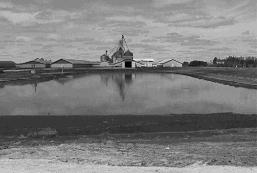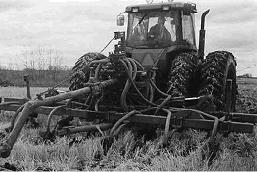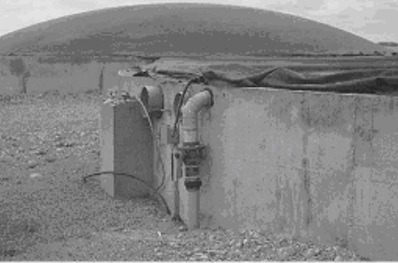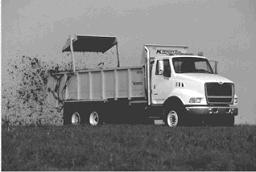| | Management to Reduce Methane Emissions from Manure | Management to Reduce Nitrous Oxide Emissions from Manure
Emissions from Livestock Manure
Livestock manure is a valuable resource for nutrients and an excellent soil amendment to improve soil quality, tilth and productivity. The main greenhouse gas (GHG) emissions from manure are: methane from decomposition without oxygen (anaerobic conditions) and nitrous oxide emitted during storage and soil application. Additional gases from manure include: ammonia and nitrogen oxides which contribute to odour and are indirect sources of nitrous oxide.
Manure management is essential for minimizing GHG emissions caused by microbial activities during manure decomposition. Factors that affect emissions from manure include temperature, oxygen level (aeration), moisture, and sources of nutrients. These factors are affected, by manure type (livestock type), diet, storage and handling of manure (pile, anaerobic lagoon, etc), and manure application (injected, incorporated, etc). Proper manure management is essential for any agricultural operation because improper use of manure can lead to negative impacts on the environment.

Manure storage in an earthen lagoon system
Photo Credit: Brian Sexton, AAFRD
Methane Emissions from Manure
During decomposition of manure the amount of methane emitted depends on:
- Manure amounts, which depend on the number of animals, the amount of feed consumed, and the digestibility of the feed.
- Animal type, the condition of the digestive tract, and the quality of the feed consumed.
- Manure handling method (liquid versus solid storage). Liquid manure management systems, such as ponds, lagoons, and holding tanks lead to anaerobic conditions, which can emit up to 80 percent of manure based methane emissions, while solid manure emits little or no methane.
- Environmental conditions (temperature and moisture). Cool temperatures decrease the activity of the micro-organisms that produce methane.
Management to Reduce Methane Emissions from Manure
General
- Avoid adding straw to manure because straw acts as a food source for anaerobic bacteria, resulting in higher methane emissions.
- Apply manure to soil as soon as possible because storing manure for long periods can encourage anaerobic decomposition and result in increased methane emissions.
- Avoid manure application when the soil is extremely wet, as this leads to anaerobic conditions that increase methane emissions.

Injection of liquid manure
Photo Credit: Tri-Provincial Initiative
Feed management
- Select livestock to genetically improve the efficiency of feed conversion by the animal to help decrease GHGs.
- Increase the digestibility of feed by mechanical (ie. chopping, grinding or pelleting feed), chemical or biological processing. This reduces the time that feed remains in the digestive tract, and can reduce methane emissions by up to 75 percent, while increasing animal productivity.
- Feed cattle additives such as ionophores that act to inhibit methane production by rumen bacteria. Ionophores can reduce methane production by 25% and feed intake by 4% without adversely affecting animal performance.
- Add edible oils, such as canola oil, to the diet. The added oils reduce methane emissions by rumen bacteria.
- Grazing management practices such as rotational grazing can improve the quality of pastures, resulting in increased animal productivity and lower GHG emissions.
- Match livestock diets to nutritional requirements, e.g. sex, age and stage of production.
Manure storage, handling and treatment technologies
Methane emissions from manure can be management with technologies to help reduce methane emissions during storage.
Cover lagoons with an impermeable floating (e.g. plastic) cover over the surface of the tank or lagoon to capture GHGs. Covers on the surface of the manure reduce the transfer of GHGs to the atmosphere by increasing resistance between the manure liquid surface and the air. To remove methane from under the cover, options include flaring the trapped gases and exhausting to the atmosphere. Burning the trapped gases in a generator can produce heat and electricity, although impurities in the gas may need to be removed. In addition to reducing methane emissions by 80% (when covers are used in conjunction with negative pressure), covers also provide good odour control.

Lagoon cover at Iron Creek Colony, Alberta
Photo Credit: Kendall Tupker
Digesters process animal waste under anaerobic conditions (no oxygen) to produce methane gas (biogas), which can then be used to generate heat and electricity as an alternative energy source. At the same time, the remaining manure can be used as a fertilizer.
Aerating manure with mechanical agitation allows microorganisms to breakdown organic material through the addition of oxygen. Aerobic decomposition of manure lowers or eliminates methane emissions, but may increase nitrous oxide emissions.
Filtering exhaust air from animal houses to remove odour-causing gases, GHGs and dust particles may provide a way to reduce methane emissions. However, more research is needed.
Composting solid manure produces a stabilized product that can be stored or spread on agricultural land with minimal odour, pathogens and weed seeds. Exposure to oxygen will reduce methane emissions, however, it can lead to increased nitrous oxide emissions. More research is needed to determine whether the process of composting emits more GHGs than the application of fresh manure.
Nitrous oxide emissions from manure
During manure storage, handling and application, manure emits nitrous oxide through nitrification or denitrification. Indirect sources of nitrous oxide include volatilization and subsequent atmospheric deposition of ammonia (NH3) and nitrogen oxides (NOX). The amount of nitrous oxide emitted depends on the type of manure storage system, the length of time the manure is stored, the composition of the manure, and climatic conditions during storage and land application.
Management to Reduce Nitrous Oxide Emissions from Manure
General
- Apply manure shortly before crop growth to allow for the maximum amount of available nitrogen to be used by the crop.
- Avoid applying manure in the late fall and winter as wet conditions lead to high emission of nitrous oxide and high nitrogen loss in the spring.
- Avoid applying manure when the weather is hot and windy, or before a storm.
- Implement soil and water management practices such as: improving drainage, avoiding soil compaction, increasing soil aeration, and using nitrification inhibitors.
- Spread manure evenly around the pasture.
- Maintain healthy pastures by implementing beneficial management grazing practices to help increase the quality of forages.
- Avoid applying excess amounts of manure because nutrients can be lost to the environment. Testing both the soil and the manure before application ensures the proper nutrient balance for plant needs and can help reduce the loss of nutrients as GHGs.

Application of solid manure
Photo Credit: AAFRD
Feed Management
- Include low protein levels and the proper balance of amino acids in the diet to minimize the amount of nitrogen excreted, particularly in urine. For example, feeding pigs low protein diets with synthetic amino acids can result in less nitrogen being excreted in the urine, reduced ammonia volatilization, and less nitrogen oxide emissions.
- Use phase feeding for swine to match diet to growth and development.
Manure Storage, Handling and Treatment
- Move fresh manure to a covered storage facility to reduce adding moisture, which reduces the amount of nitrous oxide emitted.
- Storage in below ground facilities with lower temperatures reduces microbial activities.
References
- Alberta Agriculture, Food and Rural Development (AAFRD) and University of Alberta. 2003. Development of a Farm-Level Greenhouse Gas Assessment: Identification of Knowledge Gaps and Development of a Science Plan. .
- Alberta Agriculture Research Institute Project Number 2001J204. August 31, 2003. 203 pp.
Acknowledgements
In addition to AAFRD staff, we would gratefully like to acknowledge the following external reviewers: Dr. Jerry Leonard (University of Alberta /City of Edmonton) and Dr. Xiaomei Li (Alberta Research Council). |
|